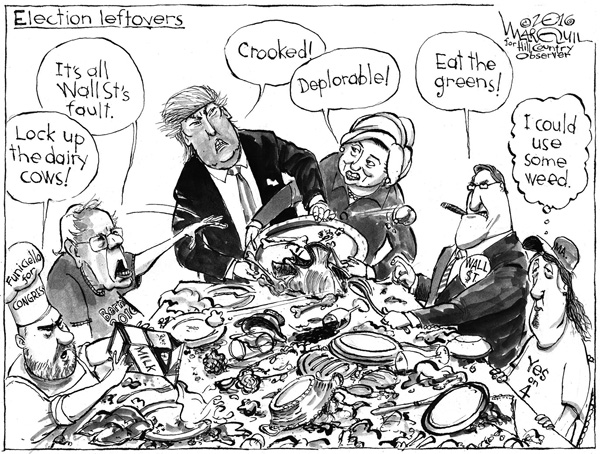Editorial November 2016
E D I T O R I A L
To heal our democracy, change how we vote
As November dawns, voters across our region are headed to the polls, inspired by a particularly high-minded campaign and impressed by the choice of so many fine candidates for public offices from the presidency on down.
Well, we can dream, can’t we? The reality, of course, is that we’ve just endured a presidential campaign that surely set a new low for its tone and lack of substance – a campaign in which every major national issue became secondary to questions about the basic fitness for office of at least one, perhaps both, of the major-party candidates.
In the presidential race and quite a few others around our region, too many voters are left feeling that their choices are at unappealing at best. For some lesser offices, there isn’t any real choice.
The result is that, even with all the news coverage generated by a presidential election year, lots of people won’t bother to vote. And many more, especially those who don’t fit neatly into either of the major parties, will vote with regret.
But what would draw more people into the democratic process, give us more choices and make our politics less toxic?
The list of worthy political reforms ought to include nonpartisan redistricting, open primaries, fewer ballot-access hurdles, same-day voter registration, and the ability to petition to put issues directly onto the ballot when legislators fail to act. (Vermont and Massachusetts each have already adopted some of these reforms; New York, none.)
More important than all of these, though, would be to reform our electoral system to give third (and fourth and fifth) parties a real chance to compete. The use of instant-runoff voting – in which voters can rank all of the candidates in order of preference – would allow minor-party candidates to compete for votes on a level playing field without being seen as spoilers.
The concept of instant-runoff voting has been endorsed by politicians as diverse as Bernie Sanders and John McCain. The system is widely used in Australia and Ireland, among other democracies, as well as in municipal elections in a number of U.S. cities, including San Francisco, Minneapolis and Portland, Maine. Vermont legislators passed a bill a few years back to try instant-runoff voting in statewide elections for U.S. House and Senate seats, but then-Gov. Jim Douglas vetoed the plan.
The details of instant-runoff voting vary depending on the jurisdiction, but the basic concept is that if no one garners more than 50 percent of the first-choice votes, the candidate with the lowest vote total is eliminated. More candidates are eliminated – and their voters’ second and, if necessary, third choices are counted -- until one of the remaining candidates gets to 50 percent.
As you might imagine, the candidates who can win under such a system tend to be moderate and pragmatic. Voters, meanwhile, are able to act with a clear conscience in choosing the candidate they like best -- without fearing that they might tip the race to a candidate whose views they abhor.
Our current electoral system, in contrast, is administered by the two major parties and is designed to marginalize third-party candidates. Because these candidates rarely have any real chance of winning, those who run often are unsuited to actually governing.
The selection of major-party nominees, meanwhile, is usually through party primaries in which the demand for ideological purity is increasingly strong. The results can be summed up in a word: polarization.


